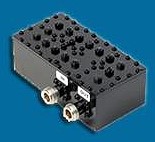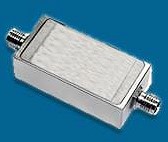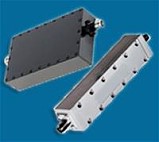Anatech Electronics Newsletter - February 2017 |

Press Release Archives: 2024 | 2023 | 2022 | 2021 |2020 2019 | 2018 | 2017 | 2016 | 2015 2014 | 2013 | 2012 | 2011 | 2010 2009 | 2008 | 2007 | 2006 | 2005 Content is copyright of company represented. Page format, custom text and images are RF Cafe copyright - do not distribute.
A Word from Sam Benzacar - PIM: A Menace That Keeps on Giving
Passive intermodulation distortion (PIM) is one of the most frustrating problems faced by engineers and technicians tasked with solving interference problems in the field. All types of wireless and broadcast installations are terrific breeding grounds for PIM that only gets more fertile as components age, and the rust and corrosion that inevitably occur in most environments make the problem even worse. PIM is nonlinear distortion caused by mixing of two signals in a passive device, producing unwanted spectral byproducts. If these signals fall in a wireless system's receive band and are strong enough, they can degrade communication channels and potentially make them unusable. The third-, fifth-, and seventh-order frequency components are of the greatest concern. PIM has long been a critical problem in communications satellites as well as military ships packed with antennas. At sea, signals from high-power communications, electronic warfare, and radar systems cause corroded bolts on the ship to act as diodes, producing undesired signals. Even minor defects like a scratch on a connector, internal connector contact depths, torque applied to mating connectors, contamination, and the contact pressure of a cover on a component such as a coupler or combiner, can cause significant increases in PIM. For many years, reducing PIM to its absolute lowest level in wireless systems wasn't essential, as it is usually at least 100 dB below the level of the desired signal. However, the intolerance of higher-order modulation techniques to PIM, dense channel spacing, and the complex combination of cables, connectors, filters, couplers, and other components (all of which may produce PIM) at tower sites have made dealing with it a problem that cannot be ignored. Fortunately, passive component manufacturers including Anatech Electronics have risen to the challenge of building components designed specifically to reduce PIM to extremely low levels and testing them thoroughly to verify their performance. This has never been trivial and test equipment capable of measuring levels as low as -150 dBc is very expensive. Nevertheless, Anatech Electronics today offers low-PIM components designed to meet the challenges posed by this insidious problem. So if you're designing communications and other systems that will ultimately find service in the field, please visit our Web site, call us at 973-772-4242, or send us an email to sales@anatechelectronics.com. What's News AT&T Ramping up AirGig Trials
Internet Access in Schools Accelerating
IoT Has Arrived
When in Dubai, Watch the Skies
Check out Our Filter Products
Cavity Band Pass Filters LC Band Pass Filters Cavity Bandstop/Notch Filter About Anatech Electronics Anatech Electronics, Inc. (AEI) specializes in the design and manufacture of standard and custom RF and microwave filters and other passive components and subsystems employed in commercial, industrial, and aerospace and applications. Products are available from an operating frequency range of 10 kHz to 30 GHz and include cavity, ceramic, crystal, LC, and surface acoustic wave (SAW), as well as power combiners/dividers, duplexers and diplexers, directional couplers, terminations, attenuators, circulators, EMI filters, and lightning arrestors. The company's custom products and capabilities are available at www.anatechelectronics.com. Contact: Anatech Electronics, Inc. 70 Outwater Lane Garfield, NJ 07026 (973) 772-4242
Posted February 22, 2017 |
 Anatech
Electronics
Anatech
Electronics By Sam Benzacar
By Sam Benzacar AT&T says it about two test its AirGig technology, which transmits
high-speed broadband over power lines. Powerline data transmission isn't new but has never been broadly
commercialized for serving the cellular industry. AT&T Labs says it is ‘writing the textbook' for
a new approach that has the potential to deliver benefits to utility companies and bring multi-gigabit,
low-cost internet connectivity anywhere there are power lines, including both urban and rural areas.
AT&T Labs started working on AirGig more than a decade ago and ultimately incorporated millimeter-wave
technology into the design. That work has resulted in more than 200 patents and patent applications
including low-cost plastic antennas, a Radio Distributed Antenna System, millimeter-wave surface launchers,
and inductive power devices.
AT&T says it about two test its AirGig technology, which transmits
high-speed broadband over power lines. Powerline data transmission isn't new but has never been broadly
commercialized for serving the cellular industry. AT&T Labs says it is ‘writing the textbook' for
a new approach that has the potential to deliver benefits to utility companies and bring multi-gigabit,
low-cost internet connectivity anywhere there are power lines, including both urban and rural areas.
AT&T Labs started working on AirGig more than a decade ago and ultimately incorporated millimeter-wave
technology into the design. That work has resulted in more than 200 patents and patent applications
including low-cost plastic antennas, a Radio Distributed Antenna System, millimeter-wave surface launchers,
and inductive power devices.  Education SuperHighway, a nonprofit focusing on upgrading Internet
access in U.S. public schools, says in its "State of the States" report that several states are leading
the way toward ensuring students have equal access to the Web. Every student in Hawaii, Kentucky, North
Dakota, South Carolina, and Wyoming meets the minimum connectivity goal of 100 Kb/s per student, according
to the report. In addition, Kentucky, Hawaii, Delaware, Tennessee, and West Virginia are working toward
having every school connected to the Internet using optical fiber. The report states that in the past
12 months, 10.4 million additional students gained the minimum required level of connectivity and 88%
of school districts are meeting basic connectivity goals.
Education SuperHighway, a nonprofit focusing on upgrading Internet
access in U.S. public schools, says in its "State of the States" report that several states are leading
the way toward ensuring students have equal access to the Web. Every student in Hawaii, Kentucky, North
Dakota, South Carolina, and Wyoming meets the minimum connectivity goal of 100 Kb/s per student, according
to the report. In addition, Kentucky, Hawaii, Delaware, Tennessee, and West Virginia are working toward
having every school connected to the Internet using optical fiber. The report states that in the past
12 months, 10.4 million additional students gained the minimum required level of connectivity and 88%
of school districts are meeting basic connectivity goals.  The Boston Consulting Group's market analysis "Winning In IoT, It's
All About the Business Processes" makes bold predictions for the future of this technology. Report predicts
that all elements of IoT including services will reach $267 billion by 2020 and that 50% of that spending
will be driven by manufacturing, transportation and logistics, and utilities. Compound Annual Growth
Rate (CAGR) rate through 2020 is predicted to be 20%, and the report indicates that predictive maintenance,
self-optimizing production, and automated inventory management will be the three top applications driving
IoT market growth.
The Boston Consulting Group's market analysis "Winning In IoT, It's
All About the Business Processes" makes bold predictions for the future of this technology. Report predicts
that all elements of IoT including services will reach $267 billion by 2020 and that 50% of that spending
will be driven by manufacturing, transportation and logistics, and utilities. Compound Annual Growth
Rate (CAGR) rate through 2020 is predicted to be 20%, and the report indicates that predictive maintenance,
self-optimizing production, and automated inventory management will be the three top applications driving
IoT market growth.  The Dubai police have introduced
30 new radars equipped with smart cameras that detect vehicle violations and upload the data to the
traffic system autonomously. The devices will help settle cases where motorists claim they haven't committed
violations. They monitor violators at intersections, targeting people who pass in the right lane and
on the shoulder, and monitor aggressive driving behavior such as not stopping at red lights, making
sudden turns, and speeding.
The Dubai police have introduced
30 new radars equipped with smart cameras that detect vehicle violations and upload the data to the
traffic system autonomously. The devices will help settle cases where motorists claim they haven't committed
violations. They monitor violators at intersections, targeting people who pass in the right lane and
on the shoulder, and monitor aggressive driving behavior such as not stopping at red lights, making
sudden turns, and speeding. 

